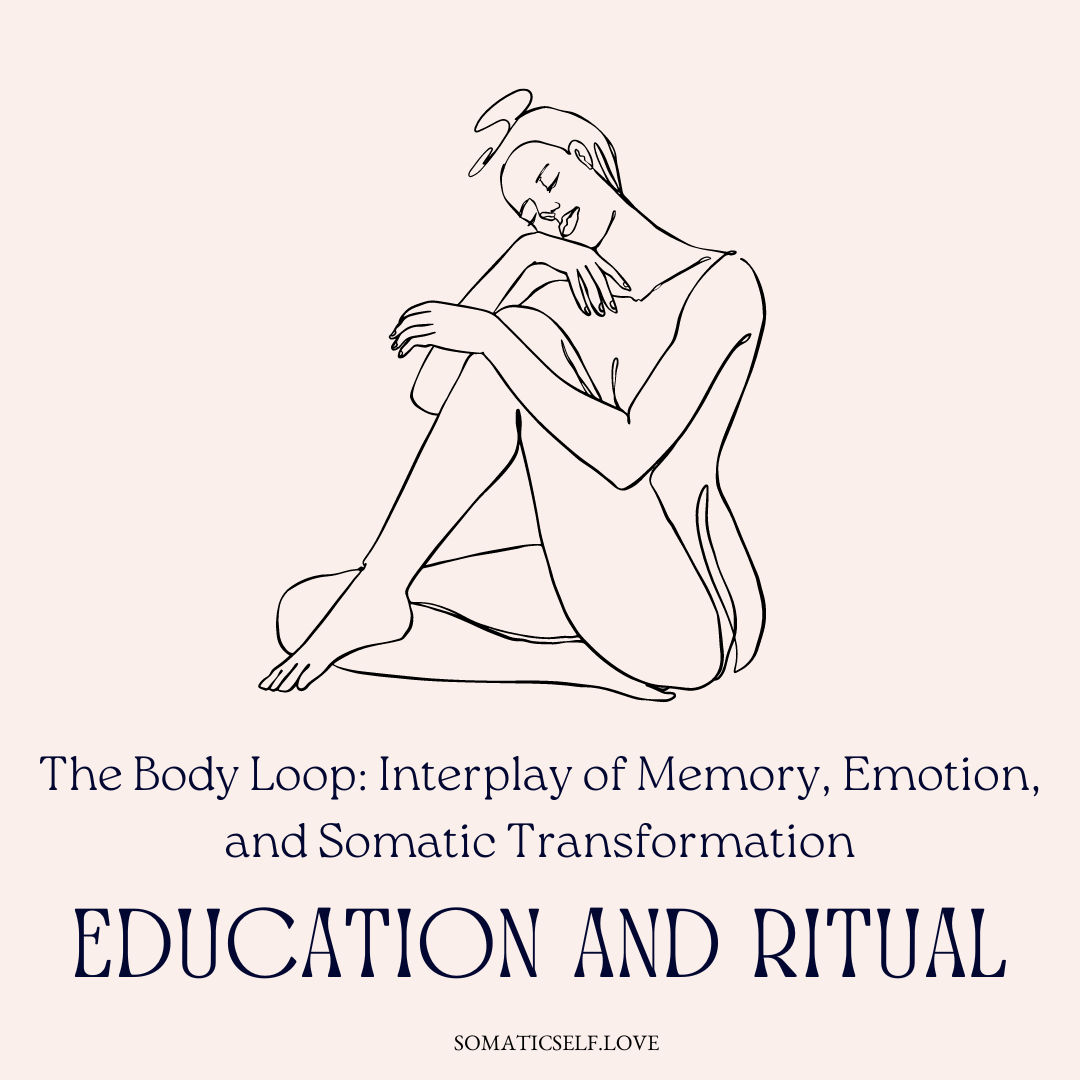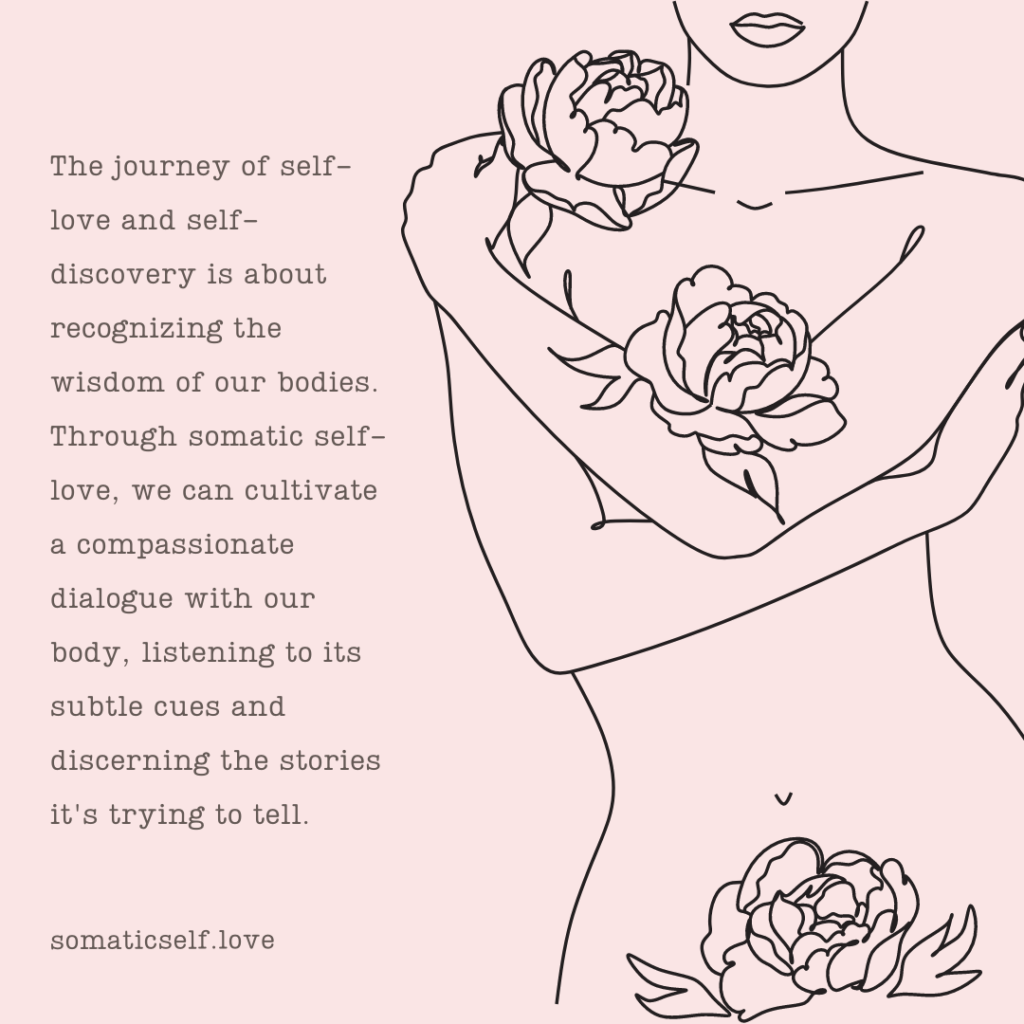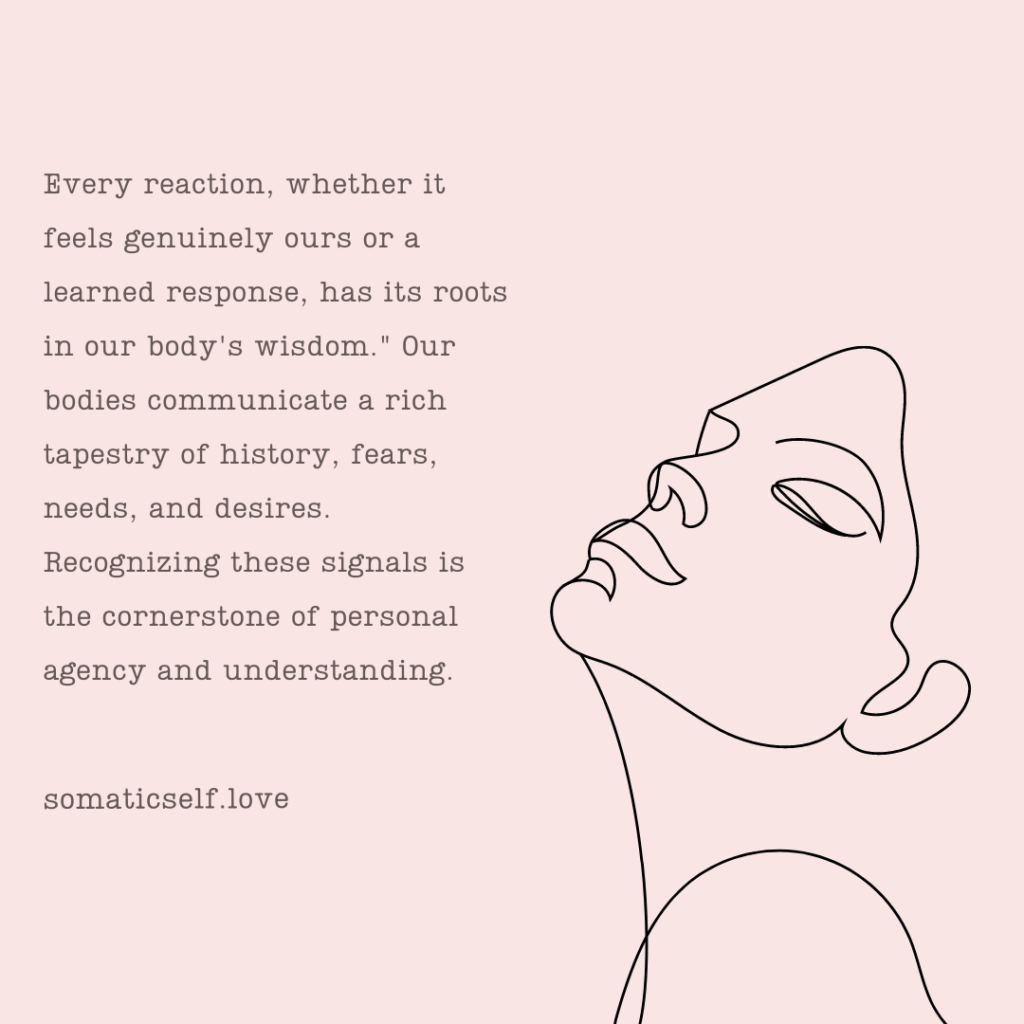The Body Loop: Interplay of Memory, Emotion, and Somatic Transformation

“In every culture and in every medical tradition before ours, healing was accomplished by moving energy.” – Alberto Villoldo.
Modern therapy approaches often sidelines the body’s role in our health and wellbeing. Emphasizing mind over matter, relegating the body’s role in our inner ecology as secondary, even inconsequential.
For the last 25 years, emerging evidence (along with age-old wisdom) suggests that the body is not a passive meat suit but an active vessel in our transformational journey.
A body loop is a term in Somatic Self-Love, encapsulating the deeply entwined interactions between memories, emotions, neurochemical stores and somatic (body-based) experiences. Stemming from past abuse and trauma, these patterns represent reflexive emotional, physiological, and psychological responses that shape our present behavior, emotions, and decisions. Derived from various therapeutic and neuroscience theories, body loops highlight how our bodies retain and replay the past influencing our ongoing relationship with ourselves and our environment.
Somatic Foundations
The body loop is a research-based synthesis of different ideas. Among others, it blends Damasio’s Somatic Marker Theory with Walker’s views on C-PTSD, enriched by van der Kolk’s “The Body Keeps the Score.” Add Gendlin’s felt-sense and the Polyvagal theory, and we arrive at the term “body loop”.
It is an iterative and often reflexive emotional/physiological/psychological pattern created by past experiences as well as the level of neurochemical trauma present within our nervous system[^1^]. Body loops represent an ingrained somatic pattern, a remembrance and reaction based on established somatic markers and trauma responses[^2^].

The journey of self-love and self-discovery is about recognizing the wisdom of our bodies. Through somatic self-love, we can cultivate a compassionate dialogue with our body, listening to its subtle cues and discerning the stories it’s trying to tell.
Damasio’s pioneering work focuses on how emotions often stemming from past experiences, guide our decision-making processes. Like a flesh library, our body stores emotional annotations, often tapping into these somatic markers to shape our current state of being and direct our choices.
CPTSD Understanding Adds Depth
Pete Walker’s in-depth analysis of C-PTSD expands this understanding[^3^]. He suggests that when these emotional markers are tinged with traumatic experiences, especially those resulting from disrupted interpersonal relationships during childhood, they have profound implications. This manifests in the form of trauma responses such as “fight, flight, fawn, and freeze.” Such responses, deeply embedded within our somatic self, perpetuate a cycle of behavior carried from the past into the present and future.
Bessel van der Kolk, a renowned expert in trauma research, famously said, “The body keeps the score”[^4^]. According to van der Kolk, our bodies hold onto traumatic memories, activating physiological responses even in the absence of conscious thought[^4^]. Over time, these loops can deeply influence our behavior, decision-making processes, and our intrinsic relationship with ourselves and our environment.
Far from being transient emotional states, these loops manifest as tangible physiological patterns. Van der Kolk poignantly notes that our bodies are diligent archivists, documenting traumatic experiences with impeccable precision.
More About the Body and Stuck Energy
These somatic theories, which form the backbone of our understanding of the body loop, emphasize the significant role our bodies play in shaping our emotions, behaviors, and overall mental health.
A foundational figure in this field, Peter Levine, developed Somatic Experiencing, a body-oriented approach to healing trauma[^5^]. Levine proposed that trauma symptoms are the effects of a frozen residue of energy that has not been resolved or discharged[^6^]. This ‘stuck’ energy is some of what we refer to in the body loop.
Additionally, findings from neuroscience research indicate that traumatic experiences can lead to significant changes in the brain and body, including alterations in the functioning of neurotransmitters and hormones[^7^]. These changes can manifest as psychosomatic symptoms, reinforcing the body loop[^8^].
C-PTSD and Body Loop
As mentioned above, Complex Post-Traumatic Stress Disorder (C-PTSD) is a condition that results from enduring abuse, often occurring over a prolonged period. People with C-PTSD often experience emotional flashbacks, which aren’t necessarily linked to specific memories but are intense reactions to feelings associated with traumatic events. These reactions are integral to understanding the body loop and how past traumas can resurface in the body.
Judith Herman, in her groundbreaking book, “Trauma and Recovery,” explains how C-PTSD impacts an individual’s physiology, leading to a chronic state of hyperarousal[^7^]. This hyperarousal is a key component of the body loop, demonstrating how our bodies can become locked in a state of heightened alertness due to unresolved trauma.
Neurochemical Underpinnings of Trauma
Beyond emotional and behavioral manifestations, trauma effects the intricate neurochemical networks of our body. We experience neurochemical shifts during traumatic events. Stress hormones like cortisol and adrenaline surge, priming the body for immediate reactive measures – the “fight or flight” response.
While these reactions serve a protective function, chronic exposure to abuse, leading to perpetual activation of this system, can have deleterious effects. This prolonged state of alert can affect neurotransmitter levels, including dopamine, serotonin, and glutamate, which govern mood, pleasure, and cognitive functions[^8^].
Over time, neurochemical imbalances, coupled with sustained high levels of stress hormones, can lead to structural and functional brain alterations. These changes further impact memory processing, mood regulation, and even influence our cognitive abilities[^9^].
The Kyriarchy: Perpetuating Collective Trauma Responses
In understanding the broader context of body loops, we look at the overarching socio-cultural systems at play. One of the systemic structures influencing our experiences is the Kyriarchy, a term coined by Elisabeth Schüssler Fiorenza, encompassing multiple intersecting social systems of domination and oppression. This complex web of power dynamics is not only about gender but also encompasses race, class, sexual orientation, age, and other socio-cultural identifiers.[^10^]:
Living within the Kyriarchy, it’s no surprise that many of us operate in a near-constant state of heightened vigilance. The repeated microaggressions, systemic discriminations, and overt oppressions contribute to an environment that perpetually triggers our “fight, flight, fawn, or freeze” responses. The stressors produce a distinctive set of physiological and psychological reactions termed as “Patriarchy Stress Disorder” (PSD). [^11^]
PSD, a term introduced by Dr. Valerie Rein, encompasses the trauma responses generated by living in a patriarchal system. However, when examining this through the lens of the Kyriarchy, we see the magnification of these stressors for those at the intersection of multiple oppressions.
And as, Kimberlé Crenshaw noted in her work on intersectionality, women, particularly women of color and transwomen, often bear the brunt of this multifaceted oppression. They navigate a world full of racial and gendered microaggressions, systemic barriers, and overt discriminatory practices.
Understanding the prevalence and pervasive nature of PSD within the framework of the Kyriarchy is vital. It underscores the need for therapeutic interventions that are not only trauma-informed but also socio-culturally attuned. Recognizing the specific and compounded traumas that individuals, especially those at multiple intersections of oppression, face is the first step towards crafting holistic and effective therapeutic strategies.
The Myth of Choice
There’s a common adage that suggests, “Although we can’t always choose what happens to us, we can always choose how we respond.” This statement, however well-intentioned, doesn’t hold true universally – it doesn’t entirely capture the complexities of human reactions.
Responses (reactions) like fight, flight, freeze, fawn, collapse, submit, and cry for help are not consciously chosen. Instead, they are deeply ingrained, unconsciously reflexive adaptive reactions often started in childhood as a way to stay safe. To survive. They become engrained into our bodies as we grow and develop – establishing well worn grooves of reflexive mind/body behaviors.
Every reaction, whether it feels genuinely ours or a learned response, has its roots in our body’s wisdom.” Our bodies communicate a rich tapestry of history, fears, needs, and desires. Recognizing these signals is the cornerstone of personal agency and understanding.

This is the power of naming body loops. We have a name, a context and a shared language through experience that helps us to begin to unwind these body loops. Through identification, we offer ourselves a framework, a shared language, and a communal understanding that aids in the process of unwinding these deeply embedded patterns.
This can feel defeating. I remember during one session with my somatic parts work supervisor… I asked “How much of me is really me? How much of it is adaptive behaviors? Engrained trauma responses? At the end of the day, how much choice do I really have?”
Embracing The Wisdom of Our Bodies
Every reaction, whether it feels genuinely ours or a learned response, has its roots in our body’s wisdom. They are our body’s way of communicating its history, fears, needs, and desires.
While some reactions might stem from old patterns or past traumas, they once served a purpose, acting as protective mechanisms or coping strategies.
Recognizing this is the first step to reclaiming agency.
Through the practice of somatic self-love, we begin to cultivate a compassionate dialogue with our body. We learn to listen to its subtle cues and discern the stories it’s trying to tell. By tuning into our body’s sensations, emotions, and impulses, we gradually unearth the layers of our ‘self’ that have been masked or overshadowed by adaptive behaviors.
Tuning into our bodies, recognizing the whispers of past traumas, and nurturing our internal world can pave the way for holistic healing. This journey is not merely about unwinding these body loops but also about redefining our relationship with ourselves.
We start to discern which reactions feel authentic and which feel automatic due to past conditioning. Over time, as we nurture this relationship with our inner self, we can lovingly reassess, reshape, and reintegrate these responses, aligning them more closely with our present desires.
A Question of Agency
So, in answer to my own question of agency: We possess profound agency, not necessarily in erasing or dismissing parts of us molded by experiences, but in recognizing, understanding, and ultimately choosing how we wish to move forward.
It’s a journey of gentle introspection, of coming home to ourselves, and realizing that every facet of you, whether born from joy or trauma, contributes to the beautiful, evolving entity that is ‘You.’
Recognizing the body loop is the first step towards healing. Through somatic self-love, we can begin to understand and gently navigate these loops[^12^]. Somatic self-love involves body-based practices that cultivate a deeper connection with ourselves, helping us become more attuned to our bodies’ signals[^13^].
Remember, the journey to coming home to ourselves is a journey of self-love. As we navigate the landscapes of our minds and bodies, let’s do so with kindness, compassion, and patience. You are not alone. Together, we can understand, embrace, and feel love for ourselves alive in our bodies.
Somatic Self-Love Ritual for Embracing Body Loops
Purpose: This ritual aims to cultivate a deeper connection with the body, recognize and understand its patterns (body loops), and foster acceptance and love for these patterns, regardless of their origin.
Materials:
- Comfortable clothing
- A soft blanket or yoga mat
- A journal and pen
- Soft, calming music (optional)
- Timer or clock
Steps:
- Preparation:
- Find a quiet space where you won’t be disturbed.
- Spread the blanket or yoga mat on the floor.
- Sit or lie down in a comfortable position. If you choose to play music, start it now.
- Grounding:
- Close your eyes and take several deep breaths, inhaling deeply through the nose and exhaling fully through the mouth.
- Visualize roots extending from the base of your spine deep into the earth, anchoring you. Feel the support of the ground beneath you.
- Body Scan:
- Starting from the toes, slowly shift your attention up through every part of your body, all the way to the top of your head.
- As you do this, notice any sensations, emotions, or memories that arise. These could be tension, warmth, tingling, discomfort, or even emotions like joy or sadness. Just notice without judgment.
- Naming the Loop:
- If you notice a particular sensation or emotion that seems to form a pattern (a body loop), give it a name. This could be something descriptive like “Tight Chest Anxiety” or symbolic like “Whirlwind Heart”.
- Tracking:
- Write down the named loops in your journal. Beside each, note down the sensations, feelings, and memories associated with it. This will help you understand and track these patterns over time.
- Acceptance Meditation:
- Bring your attention to one body loop you’ve named.
- Imagine this loop as a separate entity or energy within you. As you breathe deeply, visualize yourself sending breath, light, and space to this entity.
- Silently say to this loop, “I see you. I acknowledge you. You are a part of me.”
- Affirmative Love:
- Place one hand on your heart and the other on the location of the body loop.
- Silently or aloud, express love and gratitude for this part of yourself. You might say, “Thank you for protecting me,” or “I love you, and I’m learning from you.”
- Integration and Closing:
- Slowly begin to deepen your breath, bringing gentle movement back to your fingers and toes.
- Stretch your arms and legs, feeling the energy flow through your entire body.
- Open your eyes and take a moment to reflect on the experience, journaling any additional thoughts or insights.
- Conclude with a statement of self-love, such as “I honor and love all parts of myself, both known and unknown.”
Notes:
- This ritual can be practiced as often as needed, especially during moments of heightened stress or emotion.
- Over time, as you become more attuned to your body’s loops, you may find some patterns shifting, transforming, or even resolving.
- Always approach this ritual with a sense of compassion and curiosity, never forcing or rushing the process.
References
- [^1^]: Schore, A. N. (2001). Effects of a secure attachment relationship on right brain development, affect regulation, and infant mental health. Infant mental health journal, 22(1‐2), 7-66.
- [^2^]: Damasio, A. R. (1996). The somatic marker hypothesis and the possible functions of the prefrontal cortex [and discussion]. Philosophical transactions of the Royal Society of London. Series B: Biological sciences, 351(1346), 1413-1420.
- [^3^]:Walker, P. (2013). Complex PTSD
- [^4^]: Van der Kolk, B. (2014). The body keeps the score: Brain, mind, and body in the healing of trauma. Penguin Books.
- [^5^]: Payne, P., Levine, P. A., & Crane-Godreau, M. A. (2015). Somatic experiencing: using interoception and proprioception as core elements of trauma therapy. Frontiers in psychology, 6, 93.
- [^6^]: Levine, P. (1997). Waking the tiger: Healing trauma. North Atlantic Books.
- [^7^]: Herman, J. (1992). Trauma and recovery. Basic Books.
- [^8^]: McEwen, B. S. (2006). Protective and damaging effects of stress mediators: central role of the brain. Dialogues in clinical neuroscience, 8(4), 367.
- Neurotransmitter levels and function: Chronic exposure to stressors, including abuse, can indeed affect neurotransmitter systems. Dysregulation in neurotransmitters like serotonin, dopamine, and glutamate can influence mood, pleasure, and cognition. However, the specific ways in which these neurotransmitters change can vary depending on the nature, duration, and intensity of the stressor, as well as individual differences.
- [^9^]: Scaer, R. (2001). The body bears the burden: Trauma, dissociation, and disease. The Haworth Medical Press.
- Brain changes: It’s correct that chronic stress can lead to structural and functional brain changes. Areas such as the hippocampus (involved in memory) and the prefrontal cortex (involved in executive function and decision making) can be particularly affected. These changes can have cascading effects on memory, mood regulation, and cognition.
- [^10^]: Schüssler Fiorenza, E. (1992). But She Said: Feminist Practices of Biblical Interpretation. Beacon Press.
- [^11^]: Rein, V. (2019). Patriarchy Stress Disorder: The Invisible Inner Barrier to Women’s Happiness and Fulfillment. Difference Press.
- [^12^]: Matutes, D. (Coming Soon). Somatic Self-Love. Self-Published.
- [^13^]: Van der Kolk, B. A., Stone, L., West, J., Rhodes, A., Emerson, D., Suvak, M., & Spinazzola, J. (2014). Yoga as an adjunctive treatment for posttraumatic stress disorder: a randomized controlled trial. Journal of clinical psychiatry, 75(6), e559-e565.